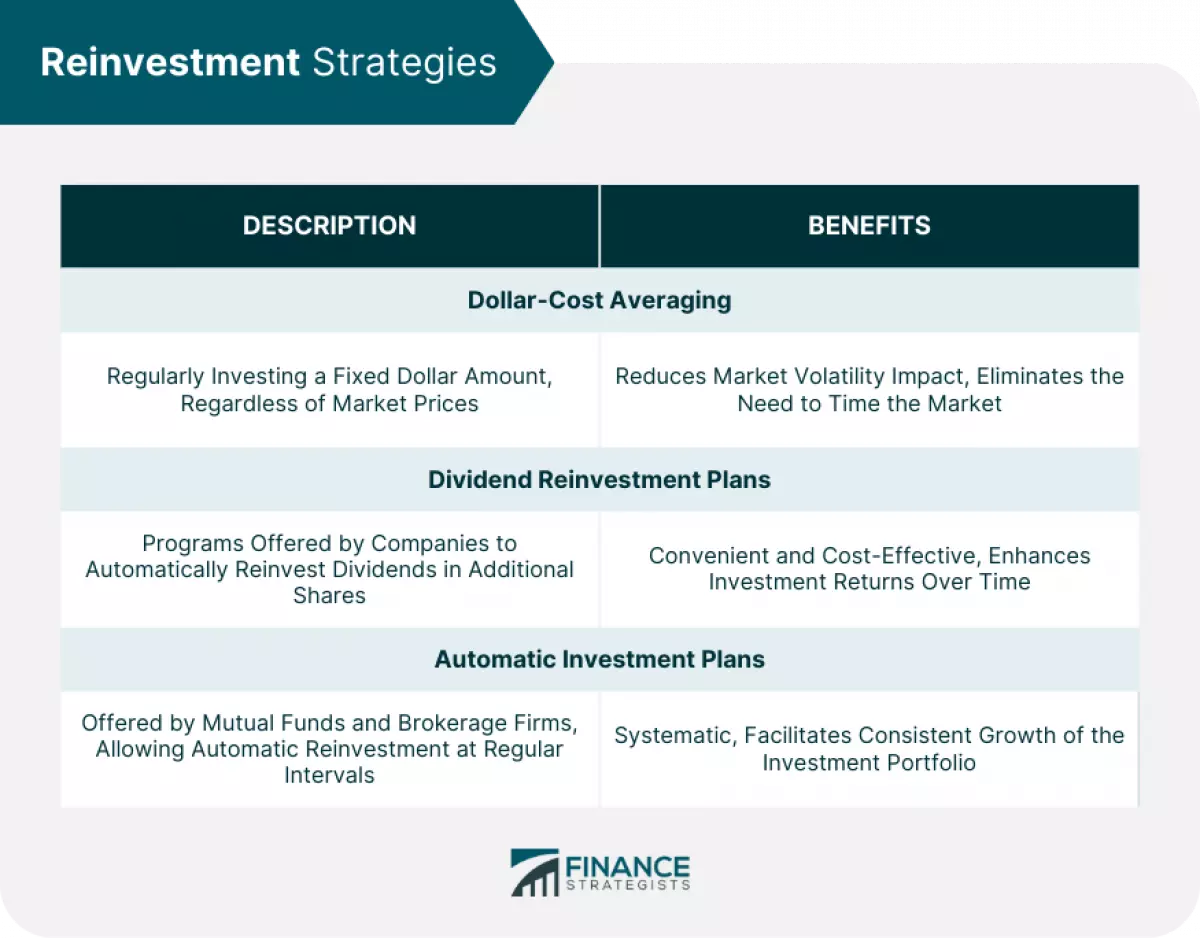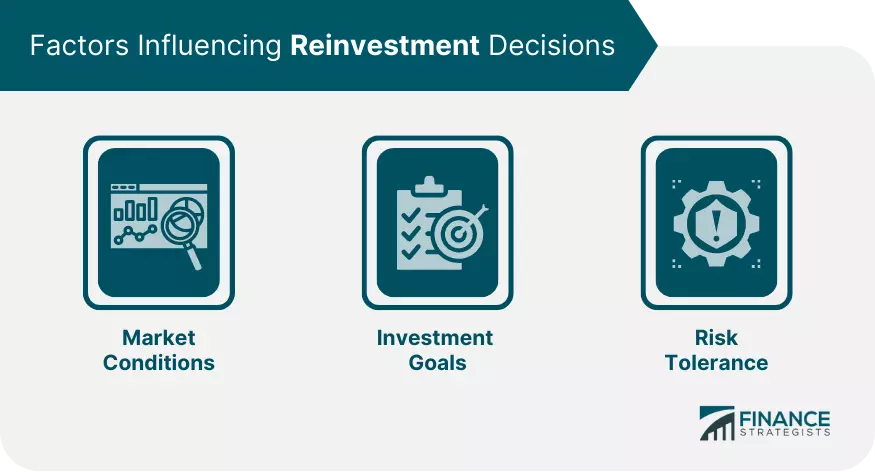Investing is not just about making money; it's about making the most of your money. Reinvestment is a strategy that allows you to do exactly that. By reinvesting the cash inflows generated from an investment, you can unlock the potential for even greater growth.
What Is Reinvestment?
At its core, reinvestment involves using the profits generated from an investment to purchase additional assets or shares instead of cashing them out. This strategic approach is a powerful tool for increasing an investor's return over time.
 Fig. 1: Reinvestment Strategies
Fig. 1: Reinvestment Strategies
Importance of Reinvestment
Role in Compounding
One of the key benefits of reinvestment is its role in compounding. It allows you to earn interest on your interest, creating a snowball effect that can exponentially grow your wealth.
Impact on Financial Growth
Reinvestment is a valuable tool for financial growth. By continually reinvesting earnings, you can exponentially increase your returns and accumulate substantial wealth, especially over a long-term investment horizon.
Reinvestment Strategies
There are a few popular reinvestment strategies that you can employ to maximize your returns:
Dollar-Cost Averaging
Dollar-cost averaging is a strategy where you invest a fixed dollar amount regularly, regardless of market prices. This approach reduces the impact of market volatility and eliminates the need to time the market, enabling you to accumulate more shares when prices are low and fewer shares when prices are high.
Dividend Reinvestment Plans (DRIPs)
Dividend Reinvestment Plans offered by companies allow shareholders to automatically reinvest their dividends in additional shares. This convenient and cost-effective method enhances your investment returns over time.
Automatic Investment Plans
Many mutual funds and brokerage firms offer automatic investment plans. These plans enable you to specify a fixed amount to be automatically reinvested at regular intervals. Like DRIPs, automatic investment plans facilitate consistent growth of your investment portfolio.
Reinvestment in Different Financial Instruments
Reinvestment can be applied to various types of financial instruments, including stocks, bonds, mutual funds, ETFs, and real estate. Here's how it works:
Stocks and Bonds
With stocks, you can reinvest dividends received to buy additional shares. Similarly, interest earned from bonds can be reinvested in more bonds. Many companies and bond issuers even offer automatic reinvestment options for dividends or interest.
Mutual Funds and ETFs
Mutual funds and ETFs provide a seamless way to compound returns through reinvestment. Any income or capital gains distributions can be automatically reinvested to purchase additional fund units.
Real Estate
Real estate investors can leverage reinvestment by reinvesting rental income into property improvements, additional real estate properties, or real estate investment trusts (REITs). This amplifies the income potential and property value.
The Reinvestment Rate
Understanding the Concept
The reinvestment rate refers to the rate of return earned on the reinvestment of cash flows. It determines the interest rate at which the income from an investment can be reinvested.
Calculating the Reinvestment Rate
The reinvestment rate can be calculated using different methods depending on the investment type. For example, for a bond, it could be the prevailing market interest rate when the interest payments are received.
Reinvestment Risk
Definition
Reinvestment risk refers to the possibility of reinvesting cash flows at a lower interest rate than the rate of the original investment. This poses a challenge when the returns from the investment need to be reinvested.
Management of Reinvestment Risk
Reinvestment risk can be managed through diversification across different investment types and maturity dates. Investing in multiple securities with varying maturity dates, known as laddering, can also help mitigate reinvestment risk.
 Fig. 2: Factors Influencing Reinvestment Decisions
Fig. 2: Factors Influencing Reinvestment Decisions
Factors Influencing Reinvestment Decisions
Several factors should be considered when making reinvestment decisions:
Market Conditions
Market conditions play a significant role in deciding whether to reinvest or hold cash. During bull markets, reinvesting dividends or profits can be highly beneficial due to rising asset prices. Conversely, during bear markets, investors might prefer safer, fixed-income securities or holding cash.
Investment Goals
Your investment goals should guide your reinvestment decisions. Long-term growth objectives may call for reinvesting all earnings, while those seeking regular income might prefer to take some or all profits as cash.
Risk Tolerance
Your risk tolerance, or ability to withstand losses or volatility, also influences reinvestment decisions. Risk-averse investors may lean towards reinvesting in less volatile securities or diversifying their investments.
Impact of Reinvestment on Portfolio Performance
Contribution to Total Returns
Reinvestment plays a significant role in boosting a portfolio's total return. By reinvesting earnings, including capital gains, dividends, or interest, you can take advantage of the power of compounding. Over the long term, reinvested earnings can contribute a substantial portion of your portfolio's total return.
Effect on Portfolio Diversification
Reinvestment can also impact portfolio diversification. By reinvesting earnings into different asset classes or sectors, you can achieve a more balanced and diversified portfolio, potentially reducing risk and enhancing returns.
Reinvestment in the Context of Retirement Planning
Role in Building Retirement Savings
Reinvestment is crucial for building retirement savings. By consistently reinvesting dividends, interest, and capital gains during your working years, you can accelerate the growth of your retirement nest egg and ensure financial security in your golden years.
Reinvestment Strategies for Retirees
Even in retirement, reinvestment remains important. While retirees may start withdrawing from their portfolios for living expenses, reinvesting a portion of the portfolio's earnings can help ensure their savings last through their retirement years.
Final Thoughts
Reinvestment is more than just a strategy; it's a way to unlock the full potential of your investments. By reinvesting your earnings, you can maximize returns, accelerate growth, and achieve your financial goals. It's crucial to consult with a financial advisor or investment professional for tailored guidance on reinvestment strategies and decisions.

















